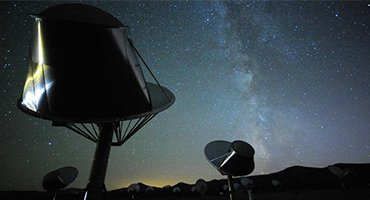CHIME Outrigger telescopes boost search for fast radio bursts

A version of this story originally appeared on the UBC Faculty of Science website.
In the quest to identify the origins of one of astronomy’s biggest mysteries – fast radio bursts (FRBs) – Canada’s world-renowned telescope, the Canadian Hydrogen Intensity Mapping Experiment (CHIME), is getting backup.
Supported by approximately $10 million in grants from the Gordon and Betty Moore Foundation, the CHIME/FRB Outriggers project has now secured funding to complete the construction of three new radio telescopes to work in conjunction with the main CHIME instrument, located in British Columbia’s Okanagan Valley.
“It’s been a pleasure to work with the talented team developing the outriggers for CHIME,” said Robert Kirshner, PhD, chief program officer for science at the Gordon and Betty Moore Foundation.
“Despite the burdens of COVID, interruptions in the supply of steel for the antennas, and competition with bitcoin miners for the specialized computer chips that power their computational wizardry, the CHIME team is headed toward a spectacular improvement in the scientific yield of CHIME’s copious FRB discoveries.”
Outriggers to sharpen CHIME’s vision
With the ability to detect 10-100 times more fast radio bursts than all other telescopes combined, CHIME has had a radical impact on FRB science. The telescope has allowed scientists to observe the vanishingly brief bursts with exquisite time resolution. CHIME’s limitation, however, has been its inability to identify with any precision where the FRBs were coming from. The outriggers will enable this radical leap.
"It’s amazing how crowded the Universe is,” said Dr. Mark Halpern, a professor in UBC’s Department of Physics and Astronomy and member of the CHIME team. “In every patch of the sky the size of the Moon there are more than a million galaxies! With these new telescopes, we will be able to tie each burst to a part of a single galaxy, learn the distance to it and the type of place these bursts occur. This will be transformative."
By pinpointing FRBs, the new telescopes will allow scientists to zoom in on the environments within galaxies from which the bursts originate and, in so doing, narrow down the possible explanations for their existence.
“The CHIME telescope can currently locate the position of a fast radio burst to a patch of sky equivalent to the size of the full Moon. With the addition of the three new outrigger telescopes, this patch of sky can be reduced to the size of a quarter held at roughly 40 km,” explained Patrick Boyle, senior project manager for the CHIME/FRB Outriggers project and senior academic associate in the Department of Physics at McGill University.
CHIME’s new siblings
The outrigger telescopes are smaller versions of the original set to be built in three locations across North America. One of the outrigger sites is near Princeton, British Columbia, on land kindly leased to CHIME by HML Mining Ltd., where construction of the new telescope’s reflector has already been completed.
The other two are the Green Bank Observatory in West Virginia and the Hat Creek Radio Observatory in California.
“By recording the same type of data at all the outrigger stations as at CHIME, we can determine how much earlier or later an FRB arrives at the outriggers and work out where the source must be on the sky,” said Dr. Ingrid Stairs, a member of the CHIME team and an astrophysicist at UBC.
Building on a successful collaboration
The CHIME/FRB Outriggers project is a collaboration between several Canadian and international institutes, including UBC, McGill University, the University of Toronto, West Virginia University and the Massachusetts Institute of Technology. Also partnering on the project is the Perimeter Institute for Theoretical Physics, the National Research Council of Canada, the National Radio Astronomy Observatory, and the Green Bank Observatory.
The outrigger project has received funding from the National Science Foundation for the electronics as well as salaries for faculty, postdocs and graduate students located in the United States.
Media Contact
Geoff Gilliard
gilliard@science.ubc.ca
604.827.5001